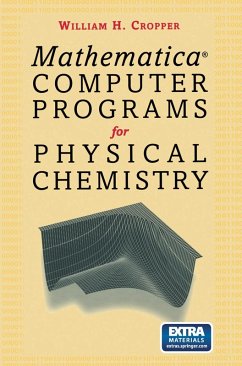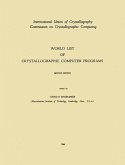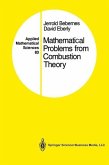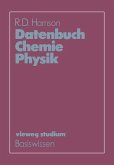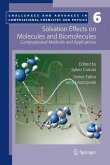William H. Cropper
Mathematica® Computer Programs for Physical Chemistry (eBook, PDF)
40,95 €
40,95 €
inkl. MwSt.
Sofort per Download lieferbar

20 °P sammeln
40,95 €
Als Download kaufen

40,95 €
inkl. MwSt.
Sofort per Download lieferbar

20 °P sammeln
Jetzt verschenken
Alle Infos zum eBook verschenken
40,95 €
inkl. MwSt.
Sofort per Download lieferbar
Alle Infos zum eBook verschenken

20 °P sammeln
William H. Cropper
Mathematica® Computer Programs for Physical Chemistry (eBook, PDF)
- Format: PDF
- Merkliste
- Auf die Merkliste
- Bewerten Bewerten
- Teilen
- Produkt teilen
- Produkterinnerung
- Produkterinnerung

Bitte loggen Sie sich zunächst in Ihr Kundenkonto ein oder registrieren Sie sich bei
bücher.de, um das eBook-Abo tolino select nutzen zu können.
Hier können Sie sich einloggen
Hier können Sie sich einloggen
Sie sind bereits eingeloggt. Klicken Sie auf 2. tolino select Abo, um fortzufahren.

Bitte loggen Sie sich zunächst in Ihr Kundenkonto ein oder registrieren Sie sich bei bücher.de, um das eBook-Abo tolino select nutzen zu können.
Physical chemistry is a standard part of every chemistry curriculum. Learning physical chemistry requires numerous detailed calculations. This book provides more than 150 Mathematica programs that allow students to apply powerful software to understand and solve the problems presented in any physical chemistry textbook. The book is organized along the same lines as most physical chemistry textbooks.
- Geräte: PC
- ohne Kopierschutz
- eBook Hilfe
- Größe: 21.91MB
Andere Kunden interessierten sich auch für
![Practical Chemoinformatics (eBook, PDF) Practical Chemoinformatics (eBook, PDF)]() Muthukumarasamy KarthikeyanPractical Chemoinformatics (eBook, PDF)40,95 €
Muthukumarasamy KarthikeyanPractical Chemoinformatics (eBook, PDF)40,95 €![Reaction Kinetics: Exercises, Programs and Theorems (eBook, PDF) Reaction Kinetics: Exercises, Programs and Theorems (eBook, PDF)]() János TóthReaction Kinetics: Exercises, Programs and Theorems (eBook, PDF)46,95 €
János TóthReaction Kinetics: Exercises, Programs and Theorems (eBook, PDF)46,95 €![World List of Crystallographic Computer Programs (eBook, PDF) World List of Crystallographic Computer Programs (eBook, PDF)]() World List of Crystallographic Computer Programs (eBook, PDF)40,95 €
World List of Crystallographic Computer Programs (eBook, PDF)40,95 €![Mathematical Problems from Combustion Theory (eBook, PDF) Mathematical Problems from Combustion Theory (eBook, PDF)]() Jerrold BebernesMathematical Problems from Combustion Theory (eBook, PDF)40,95 €
Jerrold BebernesMathematical Problems from Combustion Theory (eBook, PDF)40,95 €![Datenbuch Chemie Physik (eBook, PDF) Datenbuch Chemie Physik (eBook, PDF)]() Datenbuch Chemie Physik (eBook, PDF)36,99 €
Datenbuch Chemie Physik (eBook, PDF)36,99 €![An Introduction to Chemoinformatics (eBook, PDF) An Introduction to Chemoinformatics (eBook, PDF)]() Andrew R. LeachAn Introduction to Chemoinformatics (eBook, PDF)68,95 €
Andrew R. LeachAn Introduction to Chemoinformatics (eBook, PDF)68,95 €![Solvation Effects on Molecules and Biomolecules (eBook, PDF) Solvation Effects on Molecules and Biomolecules (eBook, PDF)]() Solvation Effects on Molecules and Biomolecules (eBook, PDF)296,95 €
Solvation Effects on Molecules and Biomolecules (eBook, PDF)296,95 €-
-
-
Physical chemistry is a standard part of every chemistry curriculum. Learning physical chemistry requires numerous detailed calculations. This book provides more than 150 Mathematica programs that allow students to apply powerful software to understand and solve the problems presented in any physical chemistry textbook. The book is organized along the same lines as most physical chemistry textbooks.
Dieser Download kann aus rechtlichen Gründen nur mit Rechnungsadresse in A, B, BG, CY, CZ, D, DK, EW, E, FIN, F, GR, HR, H, IRL, I, LT, L, LR, M, NL, PL, P, R, S, SLO, SK ausgeliefert werden.
Produktdetails
- Produktdetails
- Verlag: Springer US
- Seitenzahl: 246
- Erscheinungstermin: 6. Dezember 2012
- Englisch
- ISBN-13: 9781461222040
- Artikelnr.: 44178480
- Verlag: Springer US
- Seitenzahl: 246
- Erscheinungstermin: 6. Dezember 2012
- Englisch
- ISBN-13: 9781461222040
- Artikelnr.: 44178480
- Herstellerkennzeichnung Die Herstellerinformationen sind derzeit nicht verfügbar.
1. Preliminaries.- 1.1 Uncertainties and Units: Error.- 1.2 Gas Laws: Anderko, Beattie, Keenan1, Peng1, Virial1, Virial2, Waals.- 1.3 Data Fitting.- 1.4 Exercises.- 2. Chemical Thermodynamics in Theory.- 2.1 At High Temperatures: Deltag1, Deltag2, Deltag3.- 2.2 At High Temperatures and High Pressures: Gplot, Hp lot, Keenan2, Peng2, Peng3, Splot, Zplot.- 2.3 Calorimetric Entropies: Debye, Entropy.- 2.4 Partial Molar Quantities: Rho.- 2.5 Chemical Potential Theory.- 2.6 Ideal Solutions: Henry, Raoult.- 2.7 Nonideal Solutions: Pitzer, Vanlaar.- 2.8 Chemical Equilibrium Theory: Gibbs, Vanthoff.- 2.9 Exercises.- 3. Chemical Thermodynamics in Use.- 3.1 Geochemical Thermodynamics: Powell.- 3.2 Ordinary Equilibrium Calculations: Acetate, Coal, Haber, Na2Co3, Tcurve.- 3.3 Biochemical Thermodynamics: Atpl, Atp2, Biochem, Gprofile.- 3.4 Exercises.- 4. Quantum Theory.- 4.1 Schrödinger Equations.- 4.2 The Schrödinger Equation Solved: Schroed1, Schroed2, Schroed3, Well.- 4.3 Orbitals: Aorbital, Duality, Morbital.- 4.4 Molecular Mechanics.- 4.5 Energy Levels: Abc, Morse, Ro1, Ro2, Rovil, Viel1.- 4.6 The Hartee-Fock Equation.- 4.7 Matrix Equations: Hartree, Hueckel.- 4.8 Exercises.- 5. Spectroscopy.- 5.1 Rotational Spectroscopy: Ro3.- 5.2 Rotational-Vibrational Spectroscopy: Peaks, Rovi2, Symtop1, Symtop2.- 5.3 Vibrational-Electronic Spectroscopy: viel2.- 5.4 Rotational-Vibrational-Electronic Spectroscopy: Roviel.- 5.5 Magnetic Resonance Spectroscopy: Esr, Nmr, 2dnmr.- 5.6 Fourier-Transform Methods: Irft, Nmrft.- 5.7 Exercises.- 6. Solids, Liquids, and Surfaces.- 6.1 X-Ray Crystallography: Pattersn, Powder, Xray1, Xray2, Xray3, Xray4.- 6.2 Electron Diffraction in Gases: Elecdiff.- 6.3 Semiconductors: Fermi.- 6.4 Molecular Dynamics Simulations of Liquids: MD1, MD2, MD3 (QuickBASIC Programs).- 6.5 Monte Carlo Simulations of Liquids: MC1, MC2 (QuickBASIC Programs).- 6.6 Electrical Properties of Solid Surfaces: Gouy1, Gouy2, Gouy3.- 6.7 Surface Crystallography: Leed.- 6.8 Exercises.- 7. Macromolecules.- 7.1 Random Coils: Coil1, Coil2, Coil3.- 7.2 Macromolecules as Hydrodynamic Particles.- 7.3 Diffusion: Perrin1, Perrin2.- 7.4 Viscometry: Simha1, Simha2.- 7.5 Macromolecules as Light-Scattering Particles: Zimm.- 7.6 Exercises.- 8. Statistical Thermodynamics.- 8.1 General Methods: Mixing.- 8.2 Partition Functions: Zelec, Zrot, Zvib.- 8.3 Partition-Function Thermodynamics: Statcalc.- 8.4 Refinements: Chase.- 8.5 Statistical Chemical Thermodynamics: Statk.- 8.6 Nuclear-Spin Statistics: Cpd2, Cph2, Cphd, Statg, S&mud2, S&muh2, S&muhd.- 8.7 Exercises.- 9. Physical Kinetics.- 9.1 Maxwell's Distribution Function: Maxwell1, Maxwell2.- 9.2 Molecular Collisions: Collide.- 9.3 Diffusion: Diffuse1, Diffuse2.- 9.4 Ions in Motion: Lambda, Onsager.- 9.5 Exercises.- 10. Chemical Kinetics in Use.- 10.1 Chemical Kinetics: Chemkin, Xss.- 10.2 Complex Reaction Systems: Branch, Catcycle, Cycle, Krebs.- 10.3 Polymerization Kinetics: Chain, Step.- 10.4 Biological Kinetics: Biokin.- 10.5 Biophysical Kinetics: Hodgkin, Kgating, Nagating.- 10.6 Exercises.- 11. Chemical Kinetics in Theory.- 11.1 Reactions in Beams: Newton.- 11.2 Potential Energy Surfaces: Leps.- 11.3 Activated-Complex Theory: Eyring1, Eyring2.- 11.4 Unimolecular Reactions: Beyer, Rrkm, Whitten.- 11.5 Oscillating Reactions: Brussels, Cubecat, Cubictko, Limcycle, Oregon, Thermkin.- 11.6 Electrode Kinetics: Butler, Dme, Rde.- 11.7 Stochastic Kinetics: Stokin.- 11.8 Exercises.- Appendixes.- A. A List of the Program and Data Files on the Disk.- B. Mathematica and Physical Chemistry.- C. References.
1. Preliminaries.- 1.1 Uncertainties and Units: Error.- 1.2 Gas Laws: Anderko, Beattie, Keenan1, Peng1, Virial1, Virial2, Waals.- 1.3 Data Fitting.- 1.4 Exercises.- 2. Chemical Thermodynamics in Theory.- 2.1 At High Temperatures: Deltag1, Deltag2, Deltag3.- 2.2 At High Temperatures and High Pressures: Gplot, Hp lot, Keenan2, Peng2, Peng3, Splot, Zplot.- 2.3 Calorimetric Entropies: Debye, Entropy.- 2.4 Partial Molar Quantities: Rho.- 2.5 Chemical Potential Theory.- 2.6 Ideal Solutions: Henry, Raoult.- 2.7 Nonideal Solutions: Pitzer, Vanlaar.- 2.8 Chemical Equilibrium Theory: Gibbs, Vanthoff.- 2.9 Exercises.- 3. Chemical Thermodynamics in Use.- 3.1 Geochemical Thermodynamics: Powell.- 3.2 Ordinary Equilibrium Calculations: Acetate, Coal, Haber, Na2Co3, Tcurve.- 3.3 Biochemical Thermodynamics: Atpl, Atp2, Biochem, Gprofile.- 3.4 Exercises.- 4. Quantum Theory.- 4.1 Schrödinger Equations.- 4.2 The Schrödinger Equation Solved: Schroed1, Schroed2, Schroed3, Well.- 4.3 Orbitals: Aorbital, Duality, Morbital.- 4.4 Molecular Mechanics.- 4.5 Energy Levels: Abc, Morse, Ro1, Ro2, Rovil, Viel1.- 4.6 The Hartee-Fock Equation.- 4.7 Matrix Equations: Hartree, Hueckel.- 4.8 Exercises.- 5. Spectroscopy.- 5.1 Rotational Spectroscopy: Ro3.- 5.2 Rotational-Vibrational Spectroscopy: Peaks, Rovi2, Symtop1, Symtop2.- 5.3 Vibrational-Electronic Spectroscopy: viel2.- 5.4 Rotational-Vibrational-Electronic Spectroscopy: Roviel.- 5.5 Magnetic Resonance Spectroscopy: Esr, Nmr, 2dnmr.- 5.6 Fourier-Transform Methods: Irft, Nmrft.- 5.7 Exercises.- 6. Solids, Liquids, and Surfaces.- 6.1 X-Ray Crystallography: Pattersn, Powder, Xray1, Xray2, Xray3, Xray4.- 6.2 Electron Diffraction in Gases: Elecdiff.- 6.3 Semiconductors: Fermi.- 6.4 Molecular Dynamics Simulations of Liquids: MD1, MD2, MD3 (QuickBASIC Programs).- 6.5 Monte Carlo Simulations of Liquids: MC1, MC2 (QuickBASIC Programs).- 6.6 Electrical Properties of Solid Surfaces: Gouy1, Gouy2, Gouy3.- 6.7 Surface Crystallography: Leed.- 6.8 Exercises.- 7. Macromolecules.- 7.1 Random Coils: Coil1, Coil2, Coil3.- 7.2 Macromolecules as Hydrodynamic Particles.- 7.3 Diffusion: Perrin1, Perrin2.- 7.4 Viscometry: Simha1, Simha2.- 7.5 Macromolecules as Light-Scattering Particles: Zimm.- 7.6 Exercises.- 8. Statistical Thermodynamics.- 8.1 General Methods: Mixing.- 8.2 Partition Functions: Zelec, Zrot, Zvib.- 8.3 Partition-Function Thermodynamics: Statcalc.- 8.4 Refinements: Chase.- 8.5 Statistical Chemical Thermodynamics: Statk.- 8.6 Nuclear-Spin Statistics: Cpd2, Cph2, Cphd, Statg, S&mud2, S&muh2, S&muhd.- 8.7 Exercises.- 9. Physical Kinetics.- 9.1 Maxwell's Distribution Function: Maxwell1, Maxwell2.- 9.2 Molecular Collisions: Collide.- 9.3 Diffusion: Diffuse1, Diffuse2.- 9.4 Ions in Motion: Lambda, Onsager.- 9.5 Exercises.- 10. Chemical Kinetics in Use.- 10.1 Chemical Kinetics: Chemkin, Xss.- 10.2 Complex Reaction Systems: Branch, Catcycle, Cycle, Krebs.- 10.3 Polymerization Kinetics: Chain, Step.- 10.4 Biological Kinetics: Biokin.- 10.5 Biophysical Kinetics: Hodgkin, Kgating, Nagating.- 10.6 Exercises.- 11. Chemical Kinetics in Theory.- 11.1 Reactions in Beams: Newton.- 11.2 Potential Energy Surfaces: Leps.- 11.3 Activated-Complex Theory: Eyring1, Eyring2.- 11.4 Unimolecular Reactions: Beyer, Rrkm, Whitten.- 11.5 Oscillating Reactions: Brussels, Cubecat, Cubictko, Limcycle, Oregon, Thermkin.- 11.6 Electrode Kinetics: Butler, Dme, Rde.- 11.7 Stochastic Kinetics: Stokin.- 11.8 Exercises.- Appendixes.- A. A List of the Program and Data Files on the Disk.- B. Mathematica and Physical Chemistry.- C. References.
